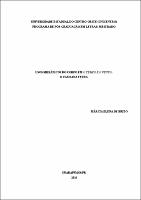| Compartilhamento |


|
Use este identificador para citar ou linkar para este item:
http://tede.unicentro.br:8080/jspui/handle/tede/97Registro completo de metadados
| Campo DC | Valor | Idioma |
|---|---|---|
| dc.creator | Brito, Marcia Elena de | - |
| dc.creator.Lattes | http://lattes.cnpq.br/5828741723188516 | por |
| dc.contributor.advisor1 | Fernandes, Márcio | - |
| dc.contributor.advisor1Lattes | http://lattes.cnpq.br/9897742006625917 | por |
| dc.date.accessioned | 2016-09-20T12:12:20Z | - |
| dc.date.available | 2016-06-30 | - |
| dc.date.issued | 2016-02-22 | - |
| dc.identifier.citation | BRITO, Marcia Elena de. USOS MIDIÁTICOS DO CORPO EM O TEMPO E O VENTO: O CASO ANA TERRA. 2016. 86 f. Dissertação (Mestrado em Inglês e Literatura Correspondente) - UNICENTRO - Universidade Estadual do Centro Oeste, Guarapuava, 2016. | por |
| dc.identifier.uri | http://localhost:8080/tede/handle/tede/97 | - |
| dc.description.resumo | Este trabalho propõe um estudo comparativo entre a personagem Ana Terra, da obra literária O Tempo e o Vento (1947), do escritor Érico Veríssimo e suas adaptações homônimas para o audiovisual em formato de minissérie (1985), dirigida por Paulo José, e cinematográfica (2013), de Jayme Monjardim. O objetivo foi verificar as transformações estéticas e de narrativa que o corpo da personagem Ana Terra sofreu quando transposta para esses meios. Para tanto, fez-se necessário retornar ao percurso da personagem na obra literária e, a partir desse ponto, discutir como ela foi interpretada nos meios midiáticos. Utilizamos como referencial teórico autores que discorrem sobre o diálogo da literatura com outras artes e, também, sobre a cultura midiática, como: Regina Zilberman, Douglas Kellner e Claus Cluver. A metodologia utilizada foi baseada, fundamentalmente, em revisão da literatura disponível comparando-a com as mídias. Buscamos, assim, as fontes primárias (os livros que compõe a trilogia, especificamente, o primeiro tomo O Continente, no qual está o capítulo da personagem Ana Terra). Ao mesmo tempo, propomos um estudo comparativo entre três tipos diferentes de mídias (livro, TV e Cinema). Buscamos portanto, discutir como ocorreu a transposição de uma importante personagem da Literatura Brasileira para a televisão e, posteriormente, para o cinema. Conclui-se que, embora partam de um mesmo ponto (a obra literária), as adaptações são obras diferentes e únicas e se adequam cada qual a seu contexto; as transformações ocorridas na personagem Ana Terra, para esses meios, foram necessárias, levando-se em conta que cada adaptação foi produzida em épocas distintas, com diferentes olhares e para diferentes públicos. | por |
| dc.description.abstract | This paper proposes a comparative study of the character Ana Terra in the novel O Tempo e o Vento (1947) by Erico Verissimo and its homonymous adaptations for audiovisual in the miniseries format (1985) directed by Paulo José, and film (2013) by Jayme Monjardín. The objective was to verify the aesthetic and narrative transformations that the body of Ana Terra character suffered when transposed to those medias. Therefor, it was necessary to return to the journey of the character in the literary work, and from that point discuss how it was interpreted in the medias . We used as theoretical framework authors who talk about the dialogue of literature with other arts and also on the mediatic culture, such as: Regina Zilberman, Douglas Kellner and Claus Cluver. The methodology used was based primarily on review of available literature comparing it to the media. We seek, therefore, the primary sources (the books that make up the trilogy, specifically the first volume, O Continentein which is the chapter of the character Ana Terra). At the same time, we propose a comparative study of three different types of media (book, TV and Cinema).It was sought, therefore, to discuss how the transposition of a major character of Brazilian literature for television and then for film ocurred. We conclude that although departing from the same point (the literary work) the adaptations are different and unique works, and fit each in its own context, and that the transformations in character Ana Terra in those medias were necessary, taking note that each adaptation was produced during distinct periods, with different looks and different audiences. | eng |
| dc.description.provenance | Made available in DSpace on 2016-09-20T12:12:20Z (GMT). No. of bitstreams: 1 PR MARCIA ELENA BRITO.pdf: 1463448 bytes, checksum: 05db623a67463dc1cd93038a8f2e4a61 (MD5) Previous issue date: 2016-02-22 | eng |
| dc.description.sponsorship | Coordenação de Aperfeiçoamento de Pessoal de Nível Superior - CAPES | - |
| dc.format | application/pdf | por |
| dc.thumbnail.url | http://localhost:8080/tede/retrieve/690/PR%20MARCIA%20ELENA%20BRITO.pdf.jpg | * |
| dc.language | por | por |
| dc.publisher | UNICENTRO - Universidade Estadual do Centro Oeste | por |
| dc.publisher.department | Unicentro::Departamento de Letras | por |
| dc.publisher.country | BR | por |
| dc.publisher.initials | UNICENTRO | por |
| dc.publisher.program | Programa de Pós-Graduação em Letras (Mestrado) | por |
| dc.rights | Acesso Aberto | por |
| dc.subject | Cinema | por |
| dc.subject | Literatura Brasileira | por |
| dc.subject | Minissérie | por |
| dc.subject | O Tempo e o Vento | por |
| dc.subject | Cinema | eng |
| dc.subject | Brazilian Literature | eng |
| dc.subject | Miniseries | eng |
| dc.subject | O Tempo e o Vento | eng |
| dc.subject.cnpq | LINGUISTICA, LETRAS E ARTES::LINGUISTICA | por |
| dc.title | USOS MIDIÁTICOS DO CORPO EM O TEMPO E O VENTO: O CASO ANA TERRA | por |
| dc.title.alternative | Mediatic use of the body in O Tempo e o Vento: Ana Terra case | eng |
| dc.type | Dissertação | por |
| Aparece nas coleções: | Programa de Pós-Graduação em Letras | |
Arquivos associados a este item:
| Arquivo | Descrição | Tamanho | Formato | |
|---|---|---|---|---|
| PR MARCIA ELENA BRITO.pdf | 1,43 MB | Adobe PDF |  Baixar/Abrir Pré-Visualizar |
Os itens no repositório estão protegidos por copyright, com todos os direitos reservados, salvo quando é indicado o contrário.




